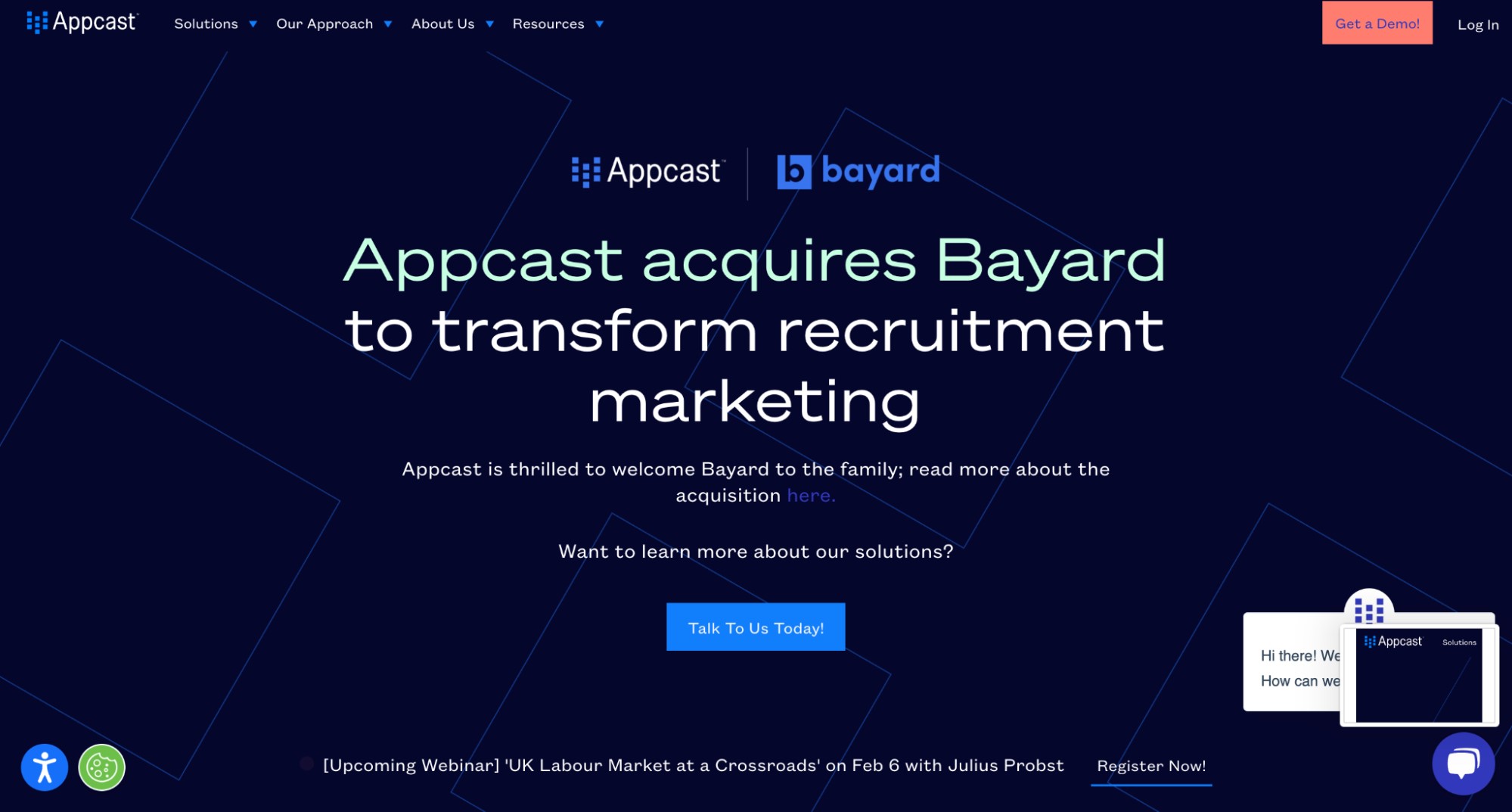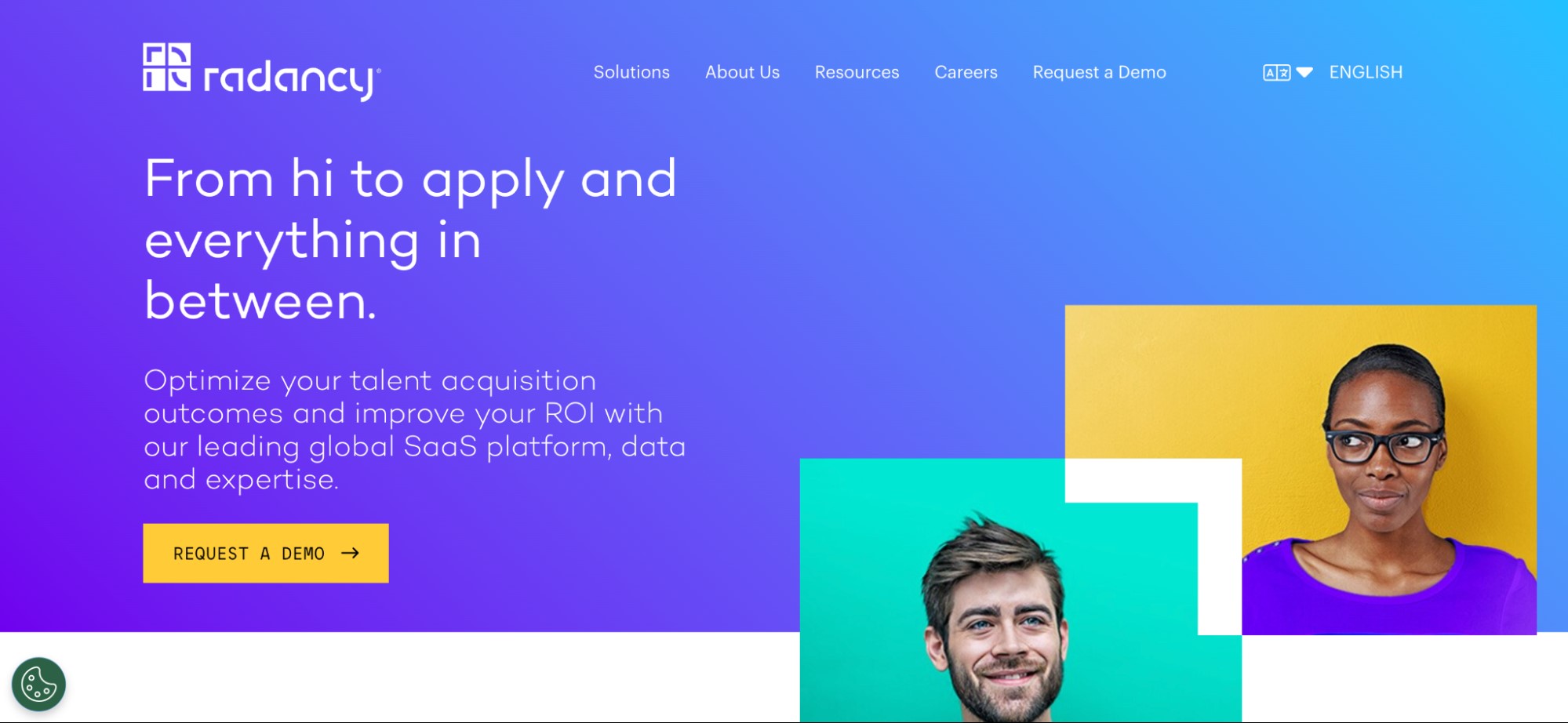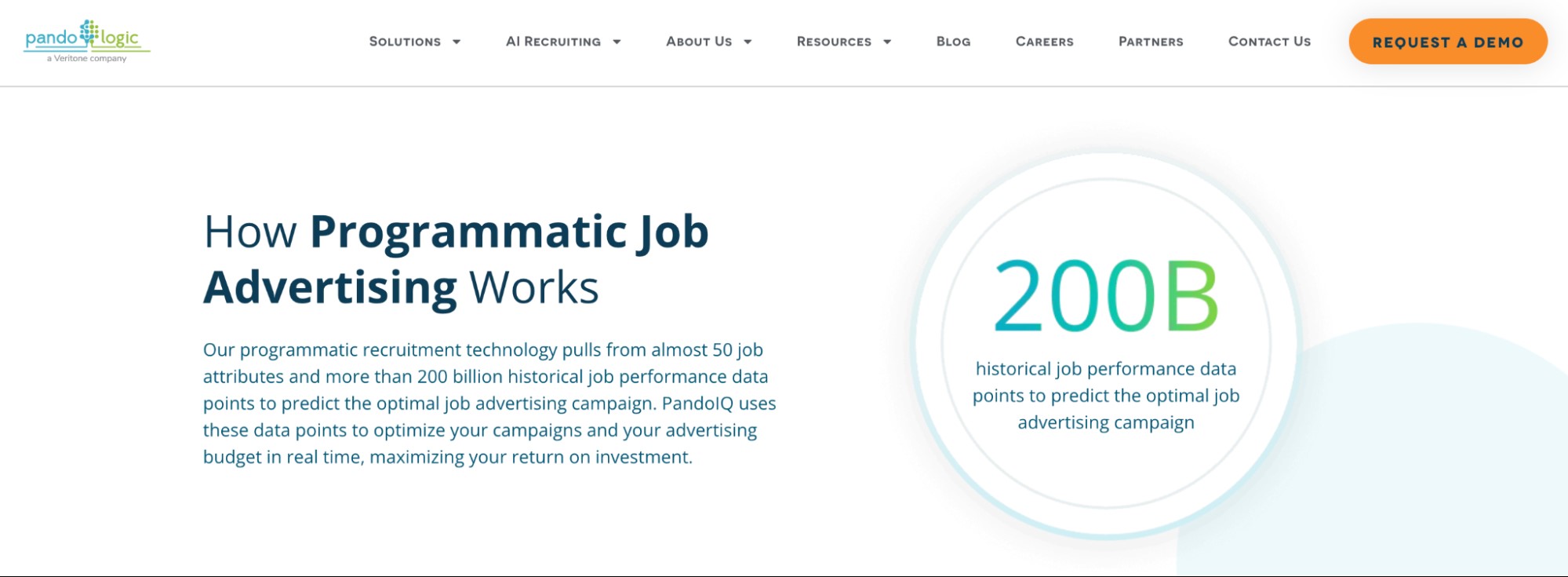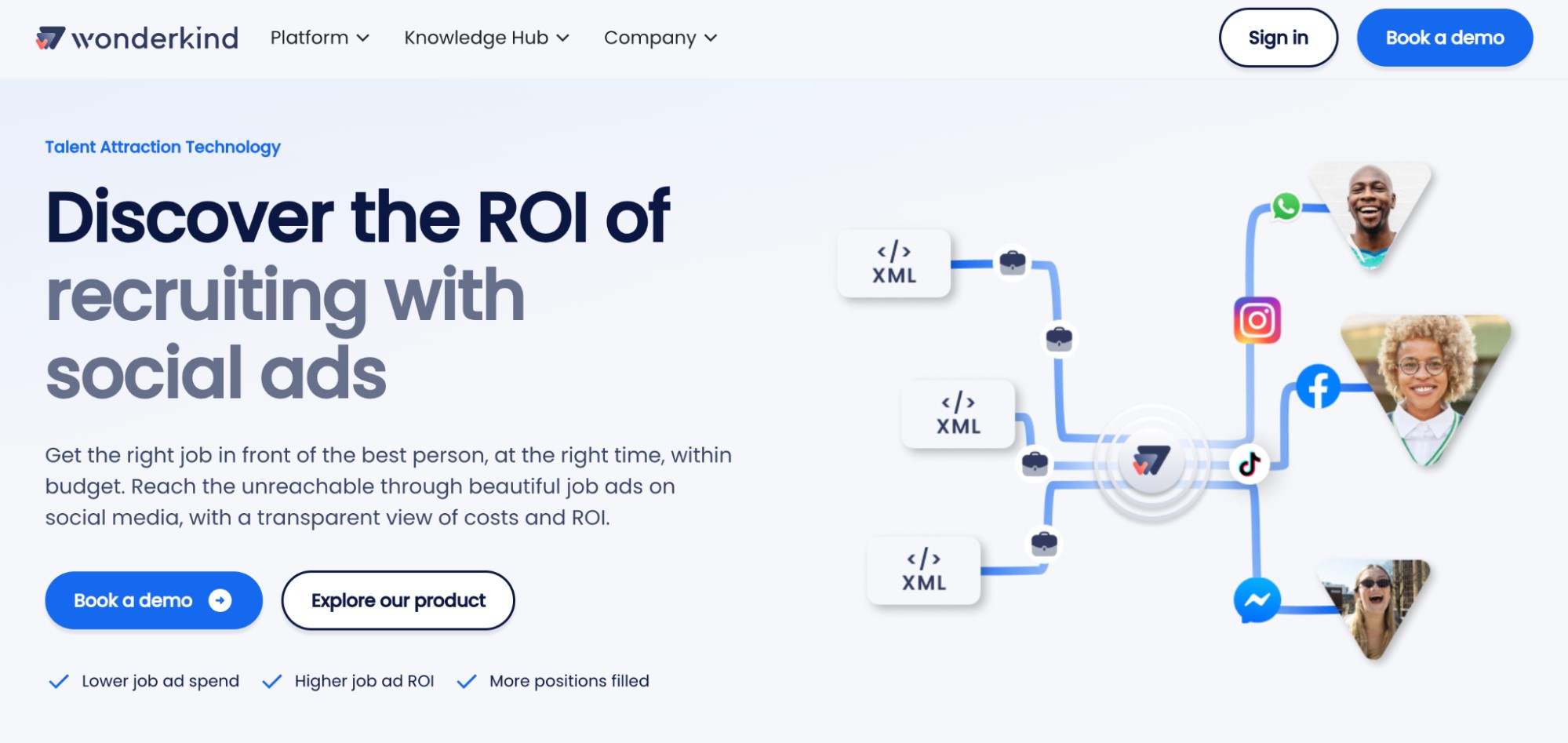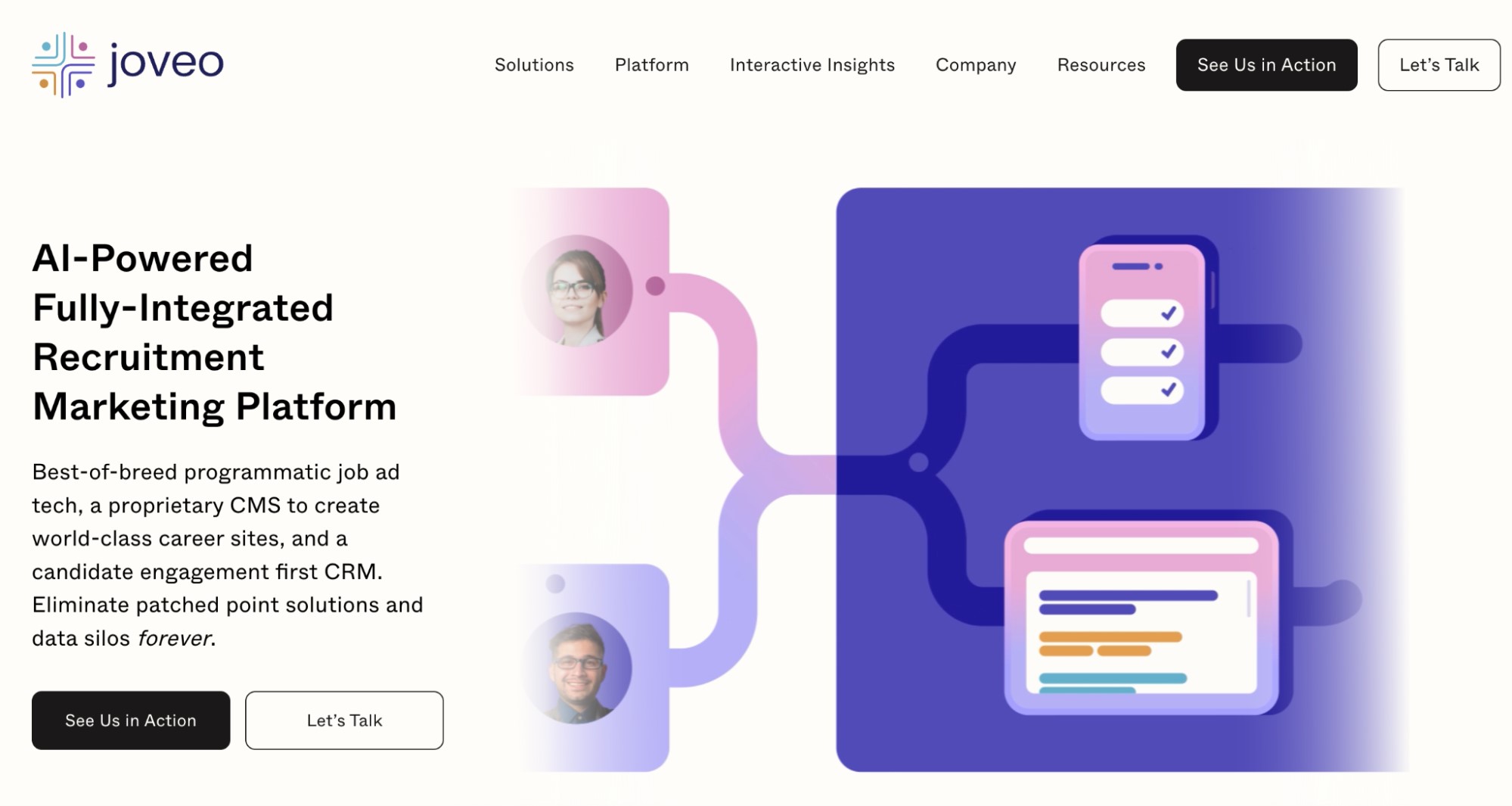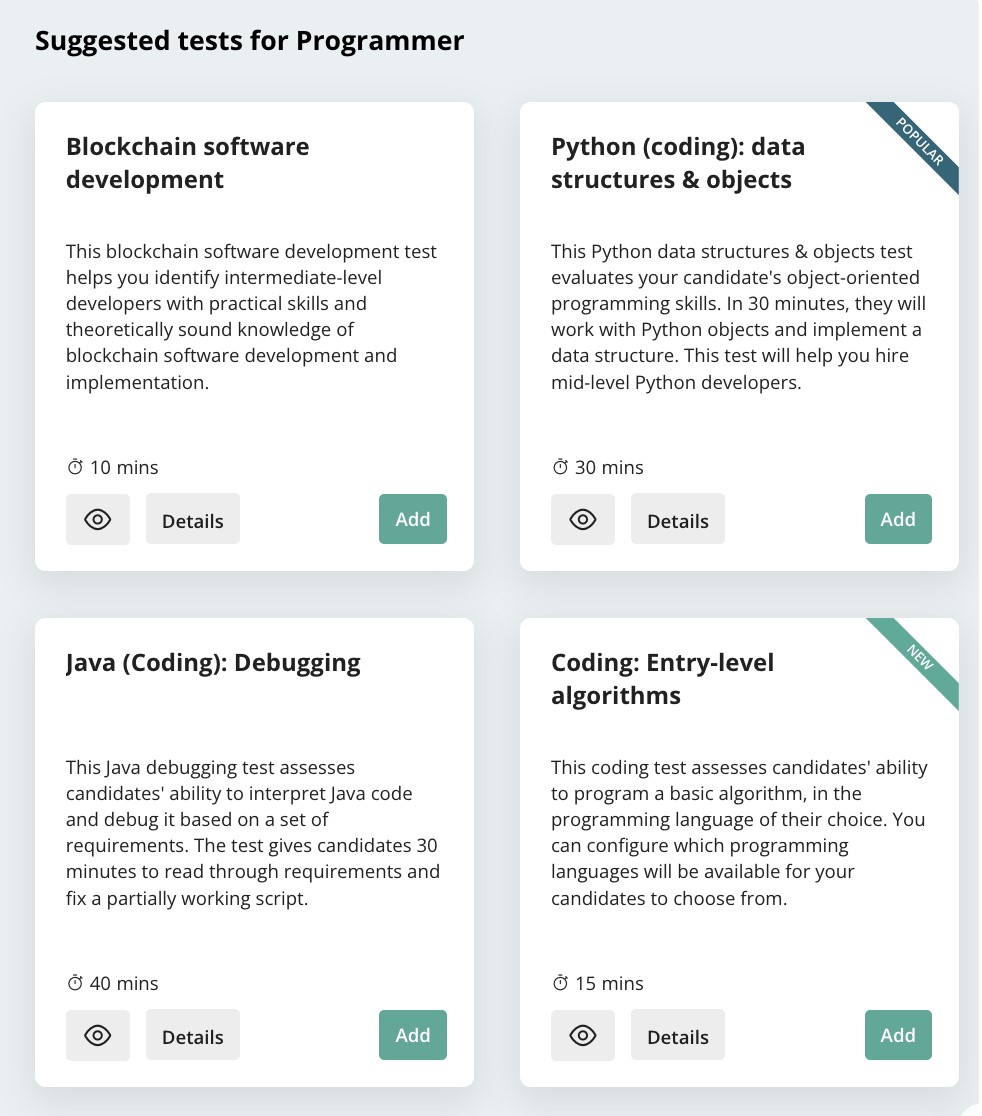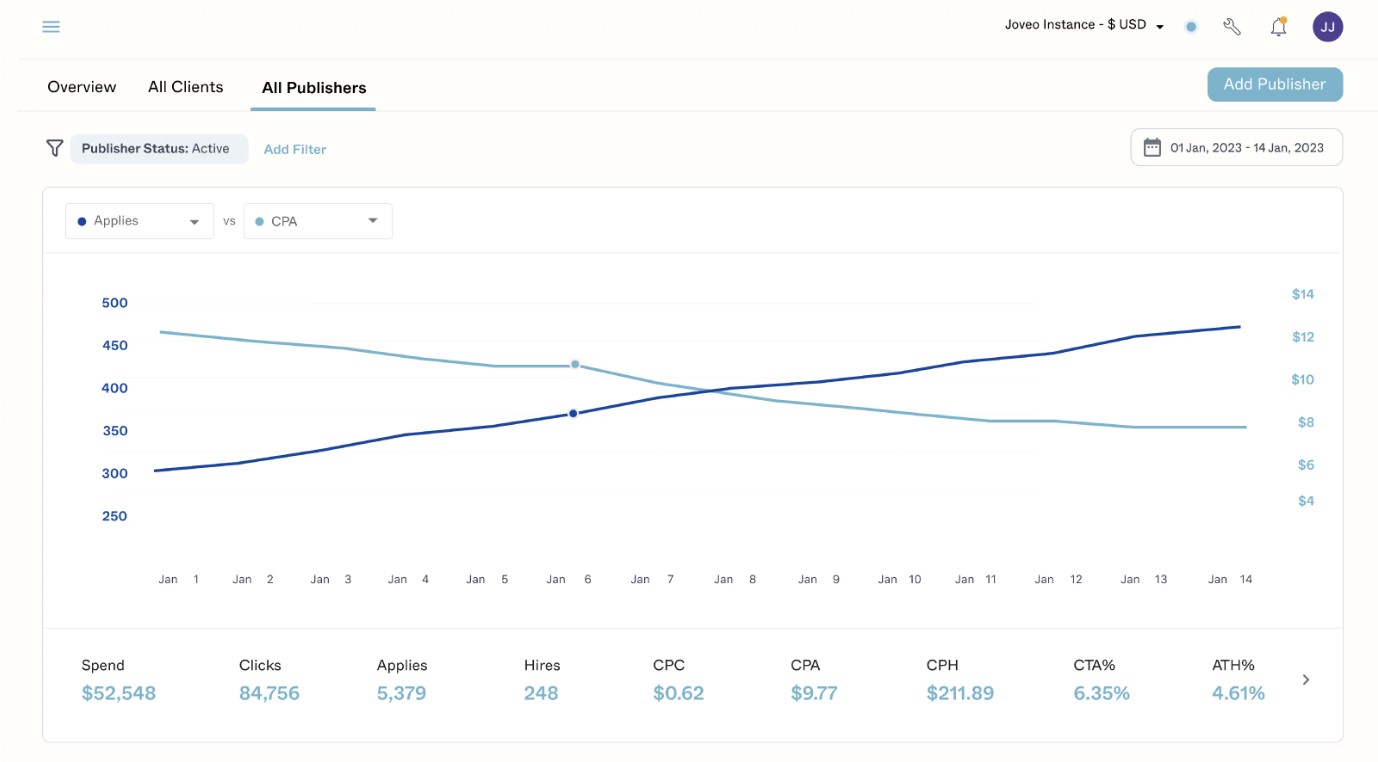Every business makes mis-hires. Finding the right talent isn’t easy; the more mistakes you make, the more time and money you waste recruiting from scratch.
These costs are no joke. Replacing a mis-hire costs up to double the salary you’d pay them in a year.[1]
Time and cost are two reasons why hiring qualified candidates the first time matters. However, getting your job advertisements in front of the right applicants can be trial and error.
It’s trial and error, that is, with traditional job advertising. You can streamline your recruitment process by bringing in HR tech, such as programmatic job advertising.
Combined with an airtight screening strategy, programmatic job ads can:
Help you reach your target audience
Cut down time-consuming admin
Give insights to help you improve job ads and marketing
Support a healthy flow of talented and communicative people
In this guide, we explore what programmatic recruitment marketing and advertising is, how it could benefit you, and the best ways to use it.
Table of contents
- What is programmatic job advertising?
- Why is programmatic job advertising software important to HR professionals?
- The benefits of programmatic job advertising platforms
- 5 best programmatic recruitment software
- 5 best practices for leveraging programmatic job advertising in your HR department
- 3 examples of companies succeeding with programmatic recruitment technology
- Use programmatic job advertising and hire ideal people fast
- Programmatic job advertising FAQs
What is programmatic job advertising?
Programmatic job advertising is an automated way of promoting roles online based on your specific recruitment needs.
Traditionally, you’d research different job boards, compare rates, and decide which options give you the best access to the talent you want to hire.
Programmatic job advertising, however, cuts out a lot of that effort and guesswork.
With programmatic ads, you use a Demand Side Platform or DSP to find the best placement opportunities. You choose these avenues based on an ideal candidate profile and the roles you want to fill.
There’s no need to keep in touch with a campaign manager or rebuild ads from scratch.
Simply tell your DSP:
The roles and responsibilities you’re hiring for
Interests your candidates should have, e.g., web design, Python coding
Where you want to advertise, e.g., social media, specific job boards
Not all DSPs follow the same templates. However, most use the data you provide on real-time bidding for ad spaces on your behalf.
After a job posting run, your DSP gives you statistics – e.g., the potential candidates you’re reaching, how many clicks your ads get, and how many people apply. You can then use this data to fine-tune your candidate and role profiles in the future.
Why is programmatic job advertising software important to HR professionals?
Time-to-hire has never been longer on average. It takes companies an average of around 44 days to fill a position.
Much of this time goes on tedious admin. HR professionals claim they spend up to 30 minutes per job posting, per board alone.[2]
Taking this statistic at face value, companies pay a whole day's HR salary for just 14 to 15 listings.
Programmatic recruitment advertising makes sense from time- and cost-saving standpoints.
Recruiters are moving toward HR technology trends such as programmatic advertising to help with the workload. Instead of manually filling out ads and searching for opportunities, they program software to get ads in front of ideal candidates.
HR professionals then have more time to build meaningful relationships with candidates and employees.
When used alongside skills testing, HR can avoid wasting time and money on resume screening software altogether.
With programmatic ads and objective talent test results, there's no need to check experience and education; you have everything you need to know about the relevant candidates’ qualifications. All that’s left is to verify ID and run background checks.
The best insights on HR and recruitment, delivered to your inbox.
Biweekly updates. No spam. Unsubscribe any time.
The benefits of programmatic job advertising platforms
By using programmatic job advertising platforms as part of your HR tech stack, you can:
Reduce costs
Improve hire quality
Open up your talent pool
Provide detailed insights
Here’s what you need to know.
Reduce costs
Programmatic ads help make your budget allocation more dynamic when it comes to ad buying. You only bid for ad placements that drive value for money and pay to advertise to specific candidates.
For example, some recruiters use DSPs to automatically outbid competitors by $0.01 if they lose a bid.
That means never having to stretch the advertising budget just to get ahead of the competition.
Let's look at NRV Pizza, a Domino's Pizza franchise that worked with pandoIQ's programmatic software.
Although it spent $200+ per store advertising jobs, the company struggled to maintain hire quality and a healthy return on investment.
Using programmatic ads, it diversified where it listed jobs, ultimately landing on more relevant sites within its network and reducing manual control.
This strategy led to an 85.8% decrease in CPA, or cost per application, and a 19% reduction in monthly recruiting costs.[3]
Improve hire quality
Programmatic ads reduce mis-hires because they focus on objective data. Advanced software can analyze candidate behavior to help ensure you’re hiring the right people.
Traditionally, you might hire people of any gender within the age bracket of 25-34. That’s a large pool of people with broad interests, skills, and personality traits.
So, you could ask a DSP to narrow searches based on interests, skills, specific job boards, and social media use to reach that demographic.
The software narrows your placement searches into multiple categories, saving hours of research and boosting your confidence.
DSPs ensure you make more job listings in the same amount of time. Therefore, you can afford to niche down.
Open up your talent pool
Although targeting niche candidates might seem restrictive, programmatic technology helps you reach people you wouldn't usually have time to find.
A DSP reaches thousands of specific job boards and listing points at once. It’s ideal for passive recruiting because you broaden your audience to include potential candidates who are not active job seekers.
This is because DSPs can even optimally advertise open jobs on websites that aren’t exclusive to job searching, such as LinkedIn.
You could then use programmatic advertising to help shape your ideal candidate profile and improve your employer branding, appealing to more discerning talent in your recruitment efforts.
Provide detailed insights
Programmatic advertising technology produces detailed HR analytics about who you target, who applies for jobs, and which applicants are successful.
You can use this information alongside skill test results from candidate assessment software to fine-tune future ads.
For example, you might find that your best data analysts score well in critical thinking tests, and you appear to hire people with longer tenure when you mention remote working.
Oracle’s research shows that HR professionals genuinely value analytics. Around 45% of the professionals the company surveyed claimed that data-driven insights are essential for recruitment and selection.
What’s more, the best programmatic advertising software gives data reports that are easy to interpret and use with other systems. You could, for example, look for tools that integrate easily with HR dashboards.
With that, let's look at some of the best programmatic job advertising software on the market.
5 best programmatic recruitment software
Below, we round up the five best programmatic job advertising tools based on our research.
Note: Remember to carefully consider your specific needs to prioritize when making a final decision. Also, please request a quote because each platform offers only customized pricing.
Factors we considered
When researching the best software to include in our guide, we considered:
Ease of use
Cost and value
Third-party integration
Customization
Specialized features
We found ease of use the most important factor to rank when judging these tools because there appears to be something of a learning curve for novices.
Programmatic job advertising software: A summary
Software | Pros | Cons |
1. Appcast | - One of the easiest programmatic job dashboards to use - Flexible pay-per-application system | - Complex integrations - Few training opportunities for data handling novices |
2. Radancy | - Creates in-depth job adverts with little input - Easy to manage employee referrals and job postings | - Restrictive commitment periods - Slight learning curve |
3. pandoIQ | - Extensive data pools for predictive analysis and real-time optimization - Powerful integrations | - Some functionality is missing compared with other tools - Complex to start with |
4. Wonderkind | - A single-platform approach to managing analytics and campaigns - In-depth HR automation wrapped in a user-friendly package | - Relatively low review footprint online |
5. Joveo | - Highly transparent whole-funnel applicant tracking - Data reports go deeper than most | - Steep learning curve - Expensive for smaller firms |
1. Appcast: Best for ease of use
Appcast delivers insights through a user-friendly dashboard that’s easy to manage and adjust.
The brand’s Xcelerate platform gives you access to thousands of specialized job sites, helping you to create job listings while tracking them in-app. The service lets you set and adjust custom goals depending on talent boards, hiring locations, and specialized markets.
The pricing system stands out, too, with a pay-per-application model and zero software fees. That means the program only charges you when you receive a genuine application rather than a pay-per-click model.
Rating at time of writing: 4.3 stars out of 5 (G2, 51 reviews)
2. Radancy: Best for candidate management
Radancy is an all-in-one programmatic recruitment marketing platform.
It stands out from other providers thanks to its broad hiring and people management coverage, with intelligent job matching alongside its own applicant tracking system.
Its technology adjusts talent acquisition needs in real-time across channels such as search engines, job boards, social networks, and email marketing.
The platform creates detailed job descriptions to help improve applicants’ experiences and expand your talent pool by targeting employee referrals.
Rating at time of writing: 4.6 stars out of 5 (G2, 96 reviews)
3. PandoIQ: Best for job performance data
PandoIQ, produced by Pandologic, is a self-learning programmatic recruiting engine working from billions of job performance data references.
The software constantly adjusts its performance based on predictive forecasting and combines insights and results in dashboards that are easy to understand and adjust.
It integrates easily with various applicant tracking systems, making it a powerful add-on to existing recruitment tools you have in place.
Rating at time of writing: 4.5 stars out of 5 (G2, 32 reviews)
4. Wonderkind: Best for AI-suggested ad improvements
Wonderkind’s programmatic advertising platform pivots toward the candidate experience, helping recruiters develop attractive, social-friendly ads.
The program uses smart profile recognition, where it scours the web and closely matches job profiles to your roles. This use of AI in HR helps you adjust job adverts over time.
The software's job feed is ideal for recruiters who struggle to track postings, offering hiring analytics and AI suggestions accessible from one platform.
Rating at time of writing: Not enough reviews for an accurate rating
5. Joveo: Best for transparency
Joveo uses machine learning to search for listing opportunities and reach out to ideal candidates.
The software’s main selling point is its transparency, giving you complete visibility across spending for individual listings, ad performance, and candidate engagement.
The system puts candidate experience first with its own CRM, helping HR update applicants on their progress.
The service’s visualizations make it a robust recruiting platform, with programmatic ads as a helpful bonus.
Rating at time of writing: 4.6 stars out of 5 (G2, 37 reviews)
5 best practices for leveraging programmatic job advertising in your HR department
Here are five tips to help you start making the most of your programmatic advertising software.
Programmatic recruiting and job advertising tips summary
Best practice | In brief |
1. Set a clear budget and goals | Decide what you want to achieve and improve with programmatic ads to maximize the value of your software |
2. Build an ideal candidate profile and use talent assessments | Use programmatic advertising to A/B test different job profiles and use the results alongside test results to influence future recruitment drives |
3. Pair programmatic job advertising with recruitment marketing | Create job ads based on employee feedback and other job profiles your DSP researches and make your company more appealing |
4. Use AI and data insights to build on your strategy | Use DSPs that learn based on your evolving needs to improve hiring quality, and use insights from your programmatic dashboard to fine-tune your ideal candidate profile |
5. Combine programmatic recruitment with talent assessments to attract top talent | Advertise for skills-based roles through your DSP and use the results to decide which skills to prioritize in the next recruitment round |
1. Set a clear budget and goals
Like other technology trends, programmatic advertising isn't worth the money unless you have clear goals. Otherwise, you're throwing money at problems that might not exist.
Before investing in the tech, consider your end goals. For example, do you want to drive more applications for a specific job role? Do you aim to improve the quality of applicants for a niche position?
For instance, you could use programmatic advertising to improve existing recruitment campaigns. Say you're hiring for a data engineer, but your turnover rate is higher than the industry average.
You could feed your job description and role requirements into a service such as Appcast, which helps you reshape how you advertise for your specific audience and then helps you break down reports from the recruiting data.
For budgeting, think carefully about using software that lets you pay per application – again, like Appcast – and only when you receive applications.
2. Build an ideal candidate profile and use talent assessments
Your ideal candidate profile (ICP) tells you exactly what a worthwhile hire for a specific position looks like.
You can use programmatic advertising technology to fine-tune this profile and repeat hiring success for time to come.
Consider using software such as Wonderkind, which runs on an A/B testing model. That means it tests out two ads with slight changes and then decides which performs better.
Say you're hiring for a graphic designer. You might set your software to look for people between the ages of 18 and 25 with skills in Adobe Illustrator. However, your DSP might advise retargeting your ad for people between 23 and 30 because doing so drives better-quality applications.
Use the data your DSP pulls into insights to help design the right candidate for a specific role.
Then, consider testing your workforce for skills and determine what specific talents your most successful employees hold. Use suggested tests provided by TestGorilla's job matching engine, for instance:
Look for patterns in the test results data. Do they suggest your best programmers are skilled in problem-solving, for example? What about specific skills in Python and Java?
Feed this information to your DSP and use it to create job profiles and descriptions that better suit your ideal hire.
3. Pair programmatic job advertising with recruitment marketing
Recruitment marketing is all about building a brand – raising awareness of who you are and the type of people you want to hire and support.
Therefore, adjust your ads via a DSP to ensure they paint your company in the best possible light.
Consider the perks and benefits your company provides. Then, ask for feedback from your existing workforce on the unofficial perks of working for your company, such as a supportive company culture. Use data from employee pulse surveys for more insight.
Some DSPs, such as pandoIQ, analyze job data to help shape how to best market you. It might, for example, suggest promoting remote working or employee wellbeing benefits.
4. Use AI and data insights to build on your strategy
One of the best reasons for investing in programmatic job advertising software is that many platforms use AI and machine learning to self-improve.
Even if the first ad run doesn't present the best candidates the first time around, self-learning software suggests how to help improve ads in the future.
Use software such as pandoIQ, which draws on billions of job profiles and constantly learns from your input.
Take note of the software's insights – was it worth promoting a particular job on social media, or is it better to try promoting on niche job boards instead to find high-quality candidates?
Couple this with HR analytics software like Joveo, known for its transparency and visual reports. Here's an example from Joveo:
If it advises that a campaign attracted lots of attention, but barely anyone made it to interviews, dig deeper into the data and make changes for the next run.
For instance, insights for a customer service role might suggest most of the people you rejected didn’t meet experience requirements. Next time, you could focus more on skills.
5. Use programmatic recruitment advertising with talent assessments to attract top talent
Although programmatic ad software can help you easily find top talent, it's only worth doing if you pair it with skills testing.
Using DSPs to target people based on experience alone could lead you back into a cycle of bad hires. Case in point: 70% of people looking for work in the US lie on their resumes, and 37% do so regularly.[4]
Lying on a resume doesn’t necessarily denote a “bad” hire. Instead, it shows us that experience checks are broadly irrelevant when judging talent if they can be easily falsified.
Testing for skills ensures you hire people based on their talent, not their experience. Skills are much harder to fake, especially if you test them firsthand. As mentioned, it’s a good idea to build a candidate profile based on skills test results from your workforce to influence your job ads.
Beyond that, use data from programmatic ad campaigns to help influence the skills you test for roles in the future.
If your DSP doesn't have access to this data, run external skills tests to measure your latest candidates before they head to interview. The more data you feed into your software, the better quality hires you expect.
You could combine this with data from performance management systems to ensure you base ads on your best existing talent.
3 examples of companies succeeding with programmatic recruitment technology
Before trying programmatic job advertising software, take inspiration from three companies that helped turn several recruiting woes around:
Koch Trucking
Life Time
KFC
Koch Trucking
Koch Trucking, a transportation firm, depends on a constant stream of talented logistics drivers to serve its customers.
Over time, the company’s marketing director found that traditional job board channels weren’t delivering the needed driver numbers. The firm then struggled to get openings in front of the right people.
Turning to Appcast, the transportation expert used a programmatic approach to advertising. It benefited from the software provider's consistent modification strategy, niching in on specific jobs instead of mass advertising.
The business regularly changed its advertising publishers thanks to the software's extensive job board reach. It allocated more budget to locations and job areas that needed more drivers.
Within the first three months of going programmatic, the company doubled its application volume and increased hires by 2.5x in the same period while keeping hire costs low.[5]
Life Time
Fitness brand Life Time regularly oversees hiring for hundreds of clubs and gyms across the US, often for specialized and competitive roles such as lifeguards and yoga instructors.
The complexity of this task proved time-consuming and difficult to scale, meaning the firm needed to find a way to increase application volumes and appeal to niche candidates.
The business turned to Joveo, which helped it to create simple application forms that tied into its Workday applicant tracker.
Additionally, the software helped the fitness brand to optimize different role keywords in its job descriptions to expand reach, for example, "Personal Trainer," "Athletic Trainer," and "Fitness Coach."
The tool's transparency helped the wellness brand gain more visibility into ad metrics such as its CPA, niching right down to the departmental level.
The partnership led to recruitment streamlining that saved hundreds of HR hours and increased applications for hard-to-fill positions.[6]
KFC
Fast food giant KFC has a healthy recruitment strategy worldwide. Still, it sets regular targets – such as its decision to double its restaurants in the Netherlands within five years.
The company needed to hire specialized, local employees quickly to achieve this. To seek out a general manager for a new Amsterdam restaurant in just three weeks, it started using Wonderkind.
Wonderkind's programmatic approach targeted the firm's regular hiring channels, listed jobs during peak interest periods, and targeted people around three miles from the restaurant.
The strategy helped the firm to hire 61 people from 77 applications during a month, keeping hiring costs low and using the programmatic software for 80% of the drive.[7]
Use programmatic job advertising and hire ideal people fast
Recruiters are under immense pressure to hire quality candidates in large numbers to short deadlines. It's possible to achieve two out of the three, but never guaranteed.
However, by using programmatic job advertising, recruiters can:
Promote roles through thousands of boards and sites at once
Fine-tune job listings with AI and machine learning
Cut down on hiring costs while finding top talent at speed
Continue to develop and improve hiring standards for time to come
Programmatic advertising is changing the way HR reaches people. Combined with skills testing, they can continue to drive down mis-hires.
If you'd like to learn more about reducing administration with cutting-edge technology, read our recruitment automation software guide.
Want to drive down mis-hiring even further?
It all starts with skills-based recruitment, so schedule a live demo with our specialists, or get started yourself with our free forever plan today!
Programmatic job advertising FAQs
To close, here are some common programmatic recruitment questions answered in full.
What is an example of a programmatic job ad strategy?
A programmatic job advertising strategy could target a specific age group five miles away from your office and advertise on hundreds of job boards at once.
A programmatic advertising tool helps you refine your target people while expanding your reach. You might then edit this campaign with your programmatic software's insights.
How does programmatic job advertising work?
Using a Demand Side Platform, or DSP, you program an automated ad manager to create and deliver job openings on websites where your ideal candidates likely see them and want to apply.
DSPs refine your ads with machine learning to reach niche audiences while advertising on thousands of channels, broadening your recruitment scope. Learn more in our guide above.
What are the disadvantages of programmatic job advertising?
Programmatic recruitment advertising could lead you to rely on outdated or incorrect data, which is why it's important to keep refreshing your campaigns.
Relying on artificial intelligence to create and distribute ads, too, can reduce creativity and appear false or suspicious to certain audiences.
What are the best programmatic job advertising programs?
Recruiting technology such as Appcast, PandoIQ, and Radancy all score well with recruiters who want to cut down time-to-hire while ensuring they find the best people for their roles.
Each program has pros and cons, however, so always compare the market. Start by reading our review of five top programmatic advertising platforms above.
Sources
McFeely, Shane; Wigert, Ben. (March 13, 2019). "This Fixable Problem Costs US Businesses $1 Trillion". Gallup Workplace. Retrieved January 28, 2024. https://www.gallup.com/workplace/247391/fixable-problem-costs-businesses-trillion.aspx
Shields, Sher. (September 29, 2022). “Estimated Time On HR: Recruiting Tasks”. Stratus HR. Retrieved January 28, 2024. https://stratus.hr/resources/estimated-time-on-hr-recruiting-tasks
“pandoIQ Provides an Applicant Boost For Domino's Pizza Franchise”. Pandologic. Retrieved January 28, 2024. https://go.pandologic.com/case-study-dominos-pizza-franchise-nrv
Szczepanek, Agata. (March 10, 2023). “The Truth about Lying to Get a Job [2023 Data]”. ResumeLab. Retrieved January 28, 2024. https://resumelab.com/career-advice/lying-to-get-a-job
“Appcast Premium Drives 2.5X Increase in Driver Hires for Koch Trucking”. Appcast Customer Story. Retrieved January 28, 2024. https://www.appcast.io/customer-story/koch-trucking/
“Life Time Scales Job Ad Reach and Simplifies Recruitment Operations”. Joveo. Retrieved January 28, 2024. https://www.joveo.com/customer-stories/life-time-scales-job-ad-reach-and-simplifies-recruitment-operations/
“How KFC lowered their cost per applicant by 87%”. Wonderkind. Retrieved January 28, 2024. https://www.wonderkind.com/cases/kentucky-fried-chicken
You've scrolled this far
Why not try TestGorilla for free, and see what happens when you put skills first.


